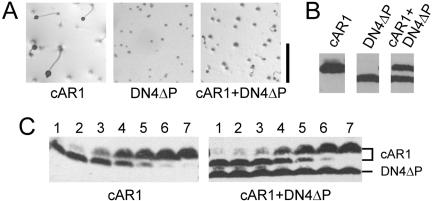Figure 3.

Effects of expressing DN4ΔP alone or with wild-type cAR1. AX3 cells expressing cAR1, DN4ΔP, or both cAR1 and DN4ΔP were obtained by transformation with pMZ80, pMZ81, or both plasmids. The stability of the cotransformant was verified by recloning and cAR1 immunoblotting (unpublished data). (A) Development on nonnutrient agar as in Figure 1. Scale bar, 1 mm. (B) Comparable cAR1 immunoblots of the cell lines depicted in A. The cells were caffeine-treated for 10 min so that cAR1 would run discretely in its nonphosphorylated form. DN4ΔP runs below cAR1 due to a 9-amino-acid deletion. (C) Dose-dependence of cAMP-induced phosphorylation of wild-type cAR1 expressed alone (left) or with DN4ΔP (right). Cells shaking at 22°C were exposed to 0, 1, 3.2, 10, 32, 100, and 1000 nM cAMP (lanes 1-7, respectively) for 10 min in the presence of 10 mM DTT and 5 mM caffeine to inhibit cAMP breakdown by PDE or amplification by ACA, respectively. Whole cell samples were immunoblotted for cAR1.
